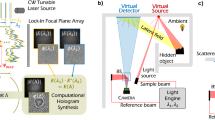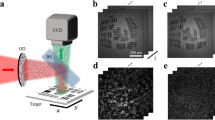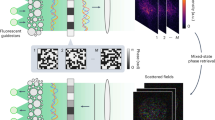Abstract
Optical imaging through scattering media is important in a variety of fields ranging from microscopy to autonomous vehicles. Although advanced wavefront shaping techniques have offered several breakthroughs in the past decade, current techniques still require a known guide star and a high-resolution spatial light modulator or a very large number of measurements and are limited in their correction field of view. Here we introduce a guide-star-free, non-invasive approach that can correct more than 190,000 scattered modes using only 25 incoherently compounded, holographically measured, scattered light fields, obtained under unknown random illuminations. This is achieved by computationally emulating an image-guided wavefront shaping experiment, where several virtual spatial light modulators are simultaneously optimized to maximize the reconstructed image quality. Our method shifts the burden from the physical hardware to a digital, naturally parallelizable computational optimization, leveraging state-of-the-art automatic differentiation tools. We demonstrate the flexibility and generality of this framework by applying it to imaging through various complex samples and imaging modalities, including epi-illumination, anisoplanatic multi-conjugate correction of highly scattering layers, lensless endoscopy in multicore fibres and acousto-optic tomography. The presented approach offers high versatility, effectiveness and generality for fast, non-invasive imaging in diverse applications.
This is a preview of subscription content, access via your institution
Access options
Access Nature and 54 other Nature Portfolio journals
Get Nature+, our best-value online-access subscription
27,99 € / 30 days
cancel any time
Subscribe to this journal
Receive 12 print issues and online access
209,00 € per year
only 17,42 € per issue
Buy this article
- Purchase on SpringerLink
- Instant access to full article PDF
Prices may be subject to local taxes which are calculated during checkout





Similar content being viewed by others
Data availability
Measurement data for Fig. 3 are available via figshare at https://doi.org/10.6084/m9.figshare.23790264 (ref. 55).
Code availability
The core optimization code is available via figshare at https://doi.org/10.6084/m9.figshare.23790264 (ref. 55) and via GitHub at https://github.com/Imaging-Lab-HUJI/Image-guided-Computational-Holographic-Wavefront-Shaping.
Change history
06 November 2024
A Correction to this paper has been published: https://doi.org/10.1038/s41566-024-01585-x
References
Ntziachristos, V. Going deeper than microscopy: the optical imaging frontier in biology. Nat. Methods 7, 603–614 (2010).
Bertolotti, J. & Katz, O. Imaging in complex media. Nat. Phys. 18, 1008–1017 (2022).
Davies, R. & Kasper, M. Adaptive optics for astronomy. Annu. Rev. Astron. Astrophys. 50, 305–351 (2012).
Lerosey, G. & Fink, M. Wavefront shaping for wireless communications in complex media: from time reversal to reconfigurable intelligent surfaces. Proc. IEEE 110, 1210–1226 (2022).
Vellekoop, I. M. & Mosk, A. P. Focusing coherent light through opaque strongly scattering media. Opt. Lett. 32, 2309–2311 (2007).
Mosk, A. P., Lagendijk, A., Lerosey, G. & Fink, M. Controlling waves in space and time for imaging and focusing in complex media. Nat. Photon. 6, 283–292 (2012).
Horstmeyer, R., Ruan, H. & Yang, C. Guidestar-assisted wavefront-shaping methods for focusing light into biological tissue. Nat. Photon. 9, 563–571 (2015).
Cao, R., de Goumoens, F., Blochet, B., Xu, J. & Yang, C. High-resolution non-line-of-sight imaging employing active focusing. Nat. Photon. 16, 462–468 (2022).
Booth, M. J., Débarre, D. & Jesacher, A. Adaptive optics for biomedical microscopy. Opt. Photonics News 23, 22–29 (2012).
Li, J. et al. Conjugate adaptive optics in widefield microscopy with an extended-source wavefront sensor. Optica 2, 682–688 (2015).
Park, J.-H., Sun, W. & Cui, M. High-resolution in vivo imaging of mouse brain through the intact skull. Proc. Natl Acad. Sci. USA 112, 9236–9241 (2015).
Papadopoulos, I. N., Jouhanneau, J.-S., Poulet, J. F. A. & Judkewitz, B. Scattering compensation by focus scanning holographic aberration probing (F-SHARP). Nat. Photon. 11, 116–123 (2017).
Badon, A. et al. Distortion matrix concept for deep optical imaging in scattering media. Sci. Adv. 6, eaay7170 (2020).
Kang, S. et al. Tracing multiple scattering trajectories for deep optical imaging in scattering media. Nat. Commun. 14, 6871 (2023).
May, M. A. et al. Fast holographic scattering compensation for deep tissue biological imaging. Nat. Commun. 12, 4340 (2021).
Freund, I., Rosenbluh, M. & Feng, S. Memory effects in propagation of optical waves through disordered media. Phys. Rev. Lett. 61, 2328–2331 (1988).
Najar, U. et al. Harnessing forward multiple scattering for optical imaging deep inside an opaque medium. Nat. Commun. 15, 7349 (2024).
Aizik, D., Gkioulekas, I. & Levin, A. Fluorescent wavefront shaping using incoherent iterative phase conjugation. Optica 9, 746–754 (2022).
Choi, W. et al. Flexible-type ultrathin holographic endoscope for microscopic imaging of unstained biological tissues. Nat. Commun. 13, 4469 (2022).
Cheng, Z., Li, C., Khadria, A., Zhang, Y. & Wang, L. V. High-gain and high-speed wavefront shaping through scattering media. Nat. Photon. 17, 299–305 (2023).
Bertolotti, J. et al. Non-invasive imaging through opaque scattering layers. Nature 491, 232–234 (2012).
Katz, O., Heidmann, P., Fink, M. & Gigan, S. Non-invasive single-shot imaging through scattering layers and around corners via speckle correlations. Nat. Photon. 8, 784–790 (2014).
Porat, A. et al. Widefield lensless imaging through a fiber bundle via speckle correlations. Opt. Express 24, 16835–16855 (2016).
Rosenfeld, M. et al. Acousto-optic ptychography. Optica 8, 936–943 (2021).
Daniel, A., Oron, D. & Silberberg, Y. Light focusing through scattering media via linear fluorescence variance maximization, and its application for fluorescence imaging. Opt. Express 27, 21778–21786 (2019).
Boniface, A., Blochet, B., Dong, J. & Gigan, S. Noninvasive light focusing in scattering media using speckle variance optimization. Optica 6, 1381–1385 (2019).
Yeminy, T. & Katz, O. Guidestar-free image-guided wavefront shaping. Sci. Adv. 7, eabf5364 (2021).
Boniface, A., Dong, J. & Gigan, S. Non-invasive focusing and imaging in scattering media with a fluorescence-based transmission matrix. Nat. Commun. 11, 6154 (2020).
Lee, H. et al. High-throughput volumetric adaptive optical imaging using compressed time-reversal matrix. Light Sci. Appl. 11, 16 (2022).
Tippie, A. E., Kumar, A. & Fienup, J. R. High-resolution synthetic-aperture digital holography with digital phase and pupil correction. Opt. Express 19, 12027–12038 (2011).
Adie, S. G., Graf, B. W., Ahmad, A., Carney, P. S. & Boppart, S. A. Computational adaptive optics for broadband optical interferometric tomography of biological tissue. Proc. Natl Acad. Sci. USA 109, 7175–7180 (2012).
Hillmann, D. et al. Aberration-free volumetric high-speed imaging of in vivo retina. Sci. Rep. 6, 35209 (2016).
Schulz, T. J. Optimal sharpness function for SAR autofocus. IEEE Signal Process. Lett. 14, 27–30 (2006).
Kamilov, U. S. et al. Learning approach to optical tomography. Optica 2, 517–522 (2015).
Feng, B. Y. et al. NeuWS: neural wavefront shaping for guidestar-free imaging through static and dynamic scattering media. Sci. Adv. 9, eadg4671 (2023).
Débarre, D., Booth, M. J. & Wilson, T. Image based adaptive optics through optimisation of low spatial frequencies. Opt. Express 15, 8176–8190 (2007).
Gabor, D. Microscopy by reconstructed wave-fronts. Proc. R. Soc. Lond. A 197, 454–487 (1949).
Paszke, A. et al. Automatic differentiation in PyTorch. NeurIPS Autodiff Workshop https://openreview.net/forum?id=BJJsrmfCZ (2017).
Muller, R. A. & Buffington, A. Real-time correction of atmospherically degraded telescope images through image sharpening. J. Opt. Soc. Am. 64, 1200–1210 (1974).
Goodman, J. W. Some fundamental properties of speckle. J. Opt. Soc. Am. 66, 1145–1150 (1976).
Beckers, J. M. Increasing the size of the isoplanatic patch with multiconjugate adaptive optics. In Very Large Telescopes and Their Instrumentation (ed. Ulrich, M.-H.) 693 (European Southern Observatory, 1988).
Li, R. et al. Rapid wide-field imaging through scattering media by digital holographic wavefront correction. Appl. Opt. 58, 2845–2853 (2019).
Andresen, E. R., Bouwmans, G., Monneret, S. & Rigneault, H. Two-photon lensless endoscope. Opt. Express 21, 20713–20721 (2013).
Plöschner, M., Tyc, T. & Čižmár, T. Seeing through chaos in multimode fibres. Nat. Photon. 9, 529–535 (2015).
Weiss, U. & Katz, O. Two-photon lensless micro-endoscopy with in-situ wavefront correction. Opt. Express 26, 28808–28817 (2018).
Kang, S. et al. High-resolution adaptive optical imaging within thick scattering media using closed-loop accumulation of single scattering. Nat. Commun. 8, 2157 (2017).
Osnabrugge, G., Horstmeyer, R., Papadopoulos, I. N., Judkewitz, B. & Vellekoop, I. M. Generalized optical memory effect. Optica 4, 886–892 (2017).
Chen, M., Ren, D., Liu, H.-Y., Chowdhury, S. & Waller, L. Multi-layer born multiple-scattering model for 3D phase microscopy. Optica 7, 394–403 (2020).
Fienup, J. R. Reconstruction of an object from the modulus of its Fourier transform. Opt. Lett. 3, 27–29 (1978).
Barré, N. & Jesacher, A. Inverse design of gradient-index volume multimode converters. Opt. Express 30, 10573–10587 (2022).
Feng, S., Kane, C., Lee, P. A. & Stone, A. D. Correlations and fluctuations of coherent wave transmission through disordered media. Phys. Rev. Lett. 61, 834–837 (1988).
Goodman, J. W. Introduction to Fourier Optics (Roberts and Company Publishers, 2005).
Fienup, J. R. & Miller, J. J. Aberration correction by maximizing generalized sharpness metrics. J. Opt. Soc. Am. A 20, 609–620 (2003).
Barzilai, J. & Borwein, J. M. Two-point step size gradient methods. IMA J. Numer. Anal. 8, 141–148 (1988).
Haim, O., Boger-Lombard, J. & Katz, O. Image-guided computational holographic wavefront shaping. figshare https://doi.org/10.6084/m9.figshare.23790264 (2024).
Acknowledgements
We thank G. Weinberg, Y. Slobodkin and E. Sunray for fruitful discussions and M. Rosenfeld for providing the acousto-optic tomography data. This work has received funding from the European Research Council under the European Union’s Horizon 2020 research and innovation programme (grant no. 101002406). This research was supported by a scholarship sponsored by the Ministry of Innovation, Science & Technology, Israel.
Author information
Authors and Affiliations
Contributions
O.K. conceived the idea. O.K., O.H. and J.B.-L. designed the experimental setup. O.H. and J.B.-L. performed the numerical simulations and data analysis. O.H. designed and implemented the automatic-differentiation-based gradient-ascent algorithm. J.B.-L. led the experimental work. J.B.-L. and O.H. performed the experiments and analysed the data under the supervision of O.K. All authors wrote the manuscript.
Corresponding author
Ethics declarations
Competing interests
The authors declare no competing interests.
Peer review
Peer review information
Nature Photonics thanks Alexandre Aubry, Monika Ritsch-Marte, Ashok Veeraraghavan and Ivo Vellekoop for their contribution to the peer review of this work.
Additional information
Publisher’s note Springer Nature remains neutral with regard to jurisdictional claims in published maps and institutional affiliations.
Supplementary information
Supplementary Information
Supplementary Sections 1–11 and Figs. 1–12.
Supplementary Video 1
Evolution of the reconstruction process over iterations, yielding the data in Fig. 2b–d (time gate 1 data).
Supplementary Video 2
Evolution of the reconstruction process over iterations, yielding the data in Fig. 2e–g (time gate 2 data).
Supplementary Video 3
Phase-corrected fields propagated to the USAF-1951 target plane, revealing the transmission image from light weakly reflected by the onion skin slice (Fig. 2h).
Supplementary Video 4
Comparison of corrected and uncorrected incoherently compounded fields from time gate 1 data (Fig. 2) as they are digitally refocused from the scattering layer to the plane of the target object.
Supplementary Video 5
Optimization of multi-conjugate reconstruction with two virtual SLM phase masks, achieving anisoplanatic correction across a wide FoV.
Supplementary Video 6
Phase and amplitude images of 100 reconstructed complex fields corresponding to the results in Fig. 3c, demonstrating access to the complex field at the object plane.
Rights and permissions
Springer Nature or its licensor (e.g. a society or other partner) holds exclusive rights to this article under a publishing agreement with the author(s) or other rightsholder(s); author self-archiving of the accepted manuscript version of this article is solely governed by the terms of such publishing agreement and applicable law.
About this article
Cite this article
Haim, O., Boger-Lombard, J. & Katz, O. Image-guided computational holographic wavefront shaping. Nat. Photon. 19, 44–53 (2025). https://doi.org/10.1038/s41566-024-01544-6
Received:
Accepted:
Published:
Issue Date:
DOI: https://doi.org/10.1038/s41566-024-01544-6
This article is cited by
-
A digital solution towards deep optical imaging
Nature Photonics (2025)
-
Multi-spectral reflection matrix for ultrafast 3D label-free microscopy
Nature Photonics (2024)



